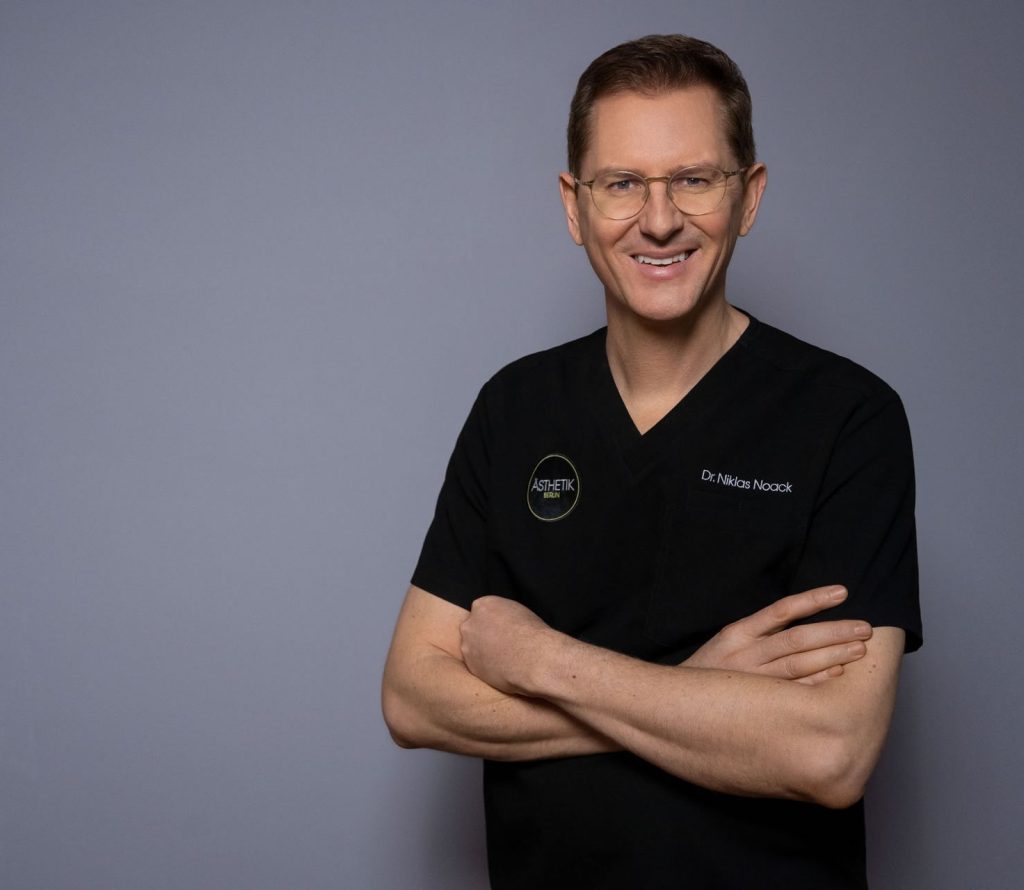Do you feel burdened by excessively large breasts or restricted in your freedom of movement? A professional breast reduction can help you to alleviate both physical and emotional discomfort and give you a new lease of life. Dr Niklas Noack, a specialist in plastic and aesthetic surgery, is at your side in Berlin with his many years of experience and expertise.
Brief information on breast reduction
| Technical term | Breast reduction surgery (mammoplasty);
Mastopexy (breast lift); |
|---|
| Goal | Breast reduction with repositioning of the nipples and tightening effect or Breast lift with repositioning of the nipples, additional augmentation with implants if necessary |
|---|
| Method | Depending on the conditions, so-called T-technique or scar-saving technique (vertical technique, I-suture, Benelli suture) |
|---|
| Duration of the operation | between 2 - 4 hours |
|---|
| Anaesthesia | General anaesthesia |
|---|
| Hospitalisation | Usually inpatient 1 - 3 days, in individual cases outpatient |
|---|
| After the operation | Special tape bandage;
Remove the drains after 1-2 days;
Dressing change after 3 days;
A slightly elevated sleeping position on the back makes sense;
Showering after dressing removal possible after a few days; |
|---|
| Pain | Medium, in combination with implant augmentation possibly somewhat stronger; |
|---|
| Follow-up treatment and behavioural recommendations | Suture removal after 12-14 days;
Compression/sports bra for 4 to 6 weeks (day and night);
2 to 3 follow-up checks;
Avoid excessive alcohol consumption and smoking for 4 weeks;
Sun exposure or solarium only after the bruising has completely disappeared;
Sauna after 8-12 weeks;
Light physical work and sporting activities after 2 - 6 weeks at the earliest; |
|---|
| Scars | Depending on the technique, more or less visible scars |
|---|
| Social and labour skills | very dependent on the individual work profile, approx. 2 - 3 weeks |
|---|
| Durability | 8 - 15 years |
|---|
| Risks | Wound healing disorders;
Partial or permanent loss of sensitivity of the nipples;
Asymmetrical nipples or breasts;
Undercorrection / overcorrection;
Circulatory disorders up to the death (necrosis) of the nipple;
Impairment of the ability to breastfeed after nipple displacement;
Limited ability to breastfeed on one or both sides;
Unsightly scarring;
General surgical risks; |
|---|
| Side effects | Swelling;
Bruising or post-operative bleeding;
Accumulation of wound fluid in the wound cavity (so-called "seroma");
Numbness and/or sensitivity to touch (temporary), especially on the nipple;
If a silicone prosthesis is implanted, corresponding side effects and risks (see also "Breast augmentation"; |
|---|
As a specialist in plastic and aesthetic surgery, the well-being of my patients is particularly important to me. The title 'specialist' stands for the highest quality standards and guarantees you comprehensive training and expertise in the field of breast reduction. We use modern methods and the latest technologies in breast reduction surgery to achieve the best possible results and maximum patient satisfaction. Put your trust in my expertise and arrange a consultation - together we will find the best solution for your individual needs.
- Dr Niklas Noack
About Dr Niklas Noack Your specialist for breast reduction
Dr Niklas Noack is a specialist in plastic and aesthetic surgery and a renowned expert in the field of breast reduction in Berlin. With his many years of experience, extensive specialist knowledge and personal consultation, Dr Noack guarantees individually tailored treatment. He places particular emphasis on quality and safety and holds a certificate of continuing medical education (CME) from the Berlin Medical Association, which is renewed every 5 years, as proof of continuous medical quality assurance.
Podcast episode by Dr Niklas Noack on breast reduction
Reasons for a breast reduction
- Health problems: Overly large breasts can lead to back, shoulder and neck pain, tension, postural problems or skin irritation.
- Aesthetic reasons: A harmonious body image can be achieved through breast reduction, especially if the breasts are disproportionately large in relation to the rest of the body.
- Psychological reasons: Reduced quality of life and self-confidence can be improved by breast reduction surgery, contributing to a more positive body image.
A breast reduction can be considered for various reasons. Whether health problems, aesthetic aspects or psychological reasons - a professionally performed breast reduction can help you to alleviate discomfort, achieve a harmonious body image and improve your quality of life.
Every patient has individual needs and reasons for a breast reduction. In a detailed consultation, we take the time to discuss your personal concerns and work together to find the right treatment option for you. We always take your health situation and your aesthetic wishes into account. My aim is to help you achieve an improved quality of life and increased self-confidence.
-
Dr Niklas Noack
Breast reduction methods
Vertical technologyAlso known as the "Lejour technique", in which the incision is made around the nipple and perpendicular to the breast crease. This method leaves fewer scars and is suitable for medium to large breast reductions.
Inverted-T technology: Also known as an "anchor scar", in which the incision runs around the nipple, perpendicular to the breast crease and horizontally along the breast crease. This technique enables more extensive breast reductions and is suitable for women with very large breasts.
Liposuction: A minimally invasive technique in which excess fatty tissue is removed by suction. This method is particularly suitable for women whose breast volume is mainly due to fatty tissue.
There are various methods of breast reduction, which differ in terms of the incision, scarring and extent of the procedure. The choice of the most suitable method depends on your individual circumstances, your breast volume and your aesthetic goals. Dr Niklas Noack will advise you competently and in detail on the most suitable method for you and tailor the procedure to your needs.
Scarring after breast reduction surgery
A common concern for patients considering a breast reduction is scarring after the operation. Breast reduction surgery results in scars, the appearance of which depends on the method chosen and the individual healing process. Dr Niklas Noack and his team attach great importance to keeping scarring to a minimum and ensuring the best possible aesthetic quality.
Depending on the breast reduction method, the scars can run differently, e.g. around the areola, vertically from the nipple to the inframammary fold or horizontally along the inframammary fold. The scars usually fade over time and become less noticeable.
To minimise scarring and optimise the aesthetic result, the following factors are crucial:
- The surgeon's experience and expertise
- The chosen surgical method
- The patient's individual wound healing and skin condition
- The right aftercare and care for scars
As a specialist in plastic and aesthetic surgery, I understand my patients' concerns about scarring after a breast reduction. My aim is to minimise scarring and give you the best possible aesthetic result. During the consultation, I will explain to you in detail how we can minimise scarring and which care measures are important for optimal wound healing and an aesthetically pleasing result. My team and I are here for you to ensure that you feel well looked after and cared for throughout the process.
-
Dr Niklas Noack
Breast reduction procedure
- Counselling interviewIn a personal consultation, Dr Noack explains the various methods of breast reduction, explains the possible risks and complications and discusses your individual expectations and wishes.
- Preliminary examinationsBefore the procedure, extensive examinations are carried out to ensure your health and to optimally plan the procedure.
- OperationBreast reduction is usually performed under general anaesthetic and takes between two and four hours, depending on the extent of the procedure.
- AftercareAfter the operation, you will be closely monitored by Dr Noack and his team in order to monitor the healing process and detect possible complications at an early stage.
The breast reduction procedure begins with a detailed consultation in which Dr Niklas Noack discusses your individual wishes and concerns and explains the various methods of breast reduction. This is followed by preliminary examinations to check your health suitability for the procedure. The operation itself is usually performed under general anaesthetic and takes between two and four hours, depending on the method chosen. Aftercare is an important part of the whole process to support your recovery and ensure an optimal result.
The breast reduction procedure is designed to offer you safety, comfort and an optimal result. From the initial consultation to aftercare, you are in good hands with us. My team and I will guide you through the entire process and are always available to answer any questions or concerns you may have. Our aim is to help you achieve a new quality of life and ensure your complete satisfaction.
-
Dr Niklas Noack
Costs and financing options
- Type and scope of the interventionThe costs vary depending on the chosen method and individual circumstances.
- Type of anaesthesiaGeneral anaesthesia or local anaesthesia also influence the costs.
- HospitalisationThe duration of the hospitalisation has an influence on the total costs.
- AftercareCosts for any follow-up treatments and check-ups.
The cost of a breast reduction depends on various factors, such as the type and extent of the procedure, the type of anaesthetic chosen, the hospital stay and aftercare. In a personal consultation, Dr Niklas Noack will explain the costs involved and provide you with a detailed cost breakdown on request.
Patient experiences and results
The satisfaction and well-being of our patients is a top priority for Dr Niklas Noack and his team. Our focus is on providing you with first-class care and support. The positive experiences and feedback from our patients emphasise the high quality of our work.
Arrange a consultation appointment for breast reduction
If you are considering a breast reduction and would like to find out about your options, Dr Niklas Noack and his team will be happy to help. In a personal consultation, Dr Noack will discuss your individual wishes and concerns and explain the various methods of breast reduction to you. This is the first step towards improving your quality of life and feeling completely comfortable in your body again.
To make an appointment for a consultation, you can contact us by phone or email. Our friendly and competent team will be happy to help you and find an appointment that suits your schedule.
I would like to invite you to make an appointment for a consultation at my practice to discuss your wishes and concerns about breast reduction. My team and I are here to answer your questions and help you make your decision. Together we will find the right solution for you to improve your quality of life and give you a new body image.
-
Dr Niklas Noack
FAQ - Frequently asked questions about breast reduction






